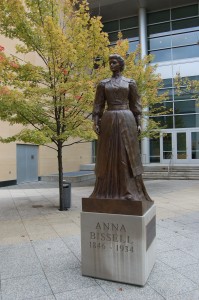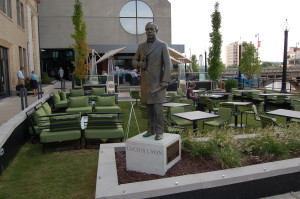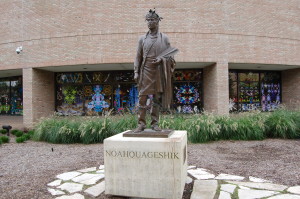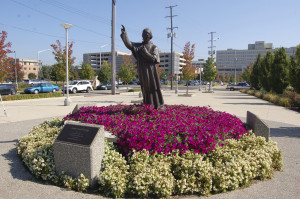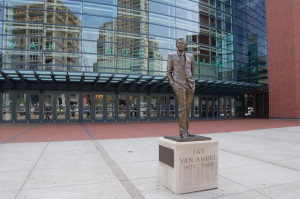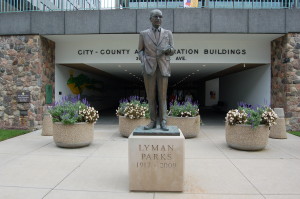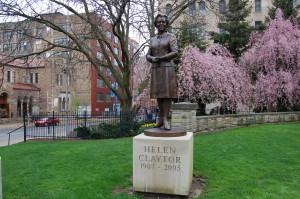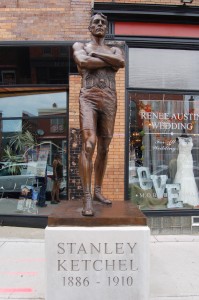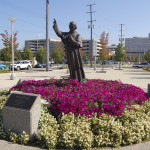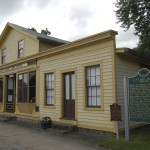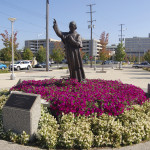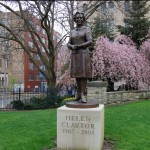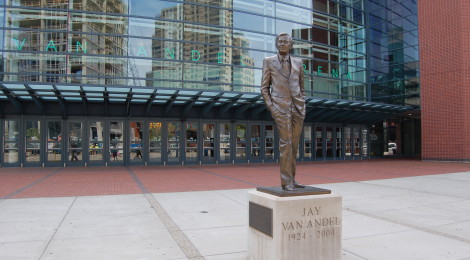
Grand Rapids Community Legends Project Sculptures: A Downtown Walking Tour
The Grand Rapids Community Legends Project commemorates the lives of significant figures in the history of Michigan’s second-largest city, and the statues can be easily viewed during a walking tour of downtown. This project was the brainchild of Peter Secchia, a local business leader and philanthropist who was the U.S. Ambassador to Italy from 1989-1993. We have included a map with this post showing where each of the eight statues currently standing are located. The eventual plan is to have 25 statues in place. The base of each statue features a plaque with a brief biography (that text is included below) and another plaque that gives the background of the Grand Rapids Community Legends Project and tells about the sculptor of each piece. Each one also includes a fitting quote from Secchia, “How will you know who you can be, if you do not know who you have been?”
Lucius Lyon (1800-1851), Statesman. “Born in Shelburne, Vermont, Lucius Lyon moved to West Michigan in 1821 and began a 30-year career as a surveyor, town developer, and legislator. He participated in the original surveys of Michigan, Illinois, and Wisconsin. In 1833-34 , Michigan’s Territorial Legislature selected Lyon as a delegate to the U.S. Congress to present its statehood petition. He served in the 1835 convention that drafted Michigan’s first constitution. Following statehood on January 26, 1837, Lyon became one of Michigan’s first U.S. Senators. In 1839, when his term expired, he moved to Grand Rapids to develop the Village of Kent, a tract of land north of Lyon Street, competing with Louis Campau’s vision of Grand Rapids. Both areas became part of the city of Grand Rapids. A member of the Board of Regents of the University of Michigan from 1837-1839, Lyon also served a term in the House of Representatives from 1843 to 1845. He then moved to Detroit to become a surveyor general for Ohio, Indiana, and Michigan until shortly before his death in 1851.” Sculpted by Stuart Williamson and Studio Eis.
located on Lyon St. west of Monroe near the outdoor dining area for The Kitchen by Wolfgang Puck.
Chief Noonday (ca 1770-1840) Ogema (Chief) of the Grand River Band of Ottawa Indians, “Noahquageshik, also referenced as Nawquageezhig and “Chief Noonday,” was a very influential Grand RiverOttawa Anishinabe (original people) leader. At the turn of the 19th century, he was one of the Ogemuk (chiefs) who led bands of the Ottawa throughout the Grand River basin. He is documented as early as the War of 1812 as an ally of Tecumseh. In 1834, as large numbers of American settles began moving into the region, Noahquageshik led the Bowtink village which was located on the west bank of the Grand River very near where this sculpture stands today. He and fellow Ogemuk assembled a Grand Council of all Ottawa bands and they agreed they would not sell their land or leave West Michigan. However, the number of American settlers grew rapidly and, faced with a U.S. government threat to move them to Kansas, the Ogemuk were forced to relinquish much of their vast territory. After the dispossession o their lands, all that remained for the Ottawa Anishinabek were several small West Michigan land reserves, including one near Manistee that remains theirs today. Grand River Ottawa Anishinabek continue to live there and in other West Michigan villages and cities. Noahquageshik died at an advanced age in 1840.” Sculpted by Antonio Tobias Mendez.
located in front of the GVSU Eberhard Center (Front Ave. NW near the blue pedestrian bridge)
Bishop Frederic Baraga, “Born in Slovenia and educated in Vienna, Baraga was ordained to the priesthood in 1823. A gifted linguist and scholar, he came to the United States in 1830 and became an authority on Odawa and Ojibwa languages. After a brief stay in Cincinnati, he traveled to Michigan and dedicated himself to the American Indian missions and the region of the Upper Midwest. In 1833, Father Baraga came to the Grand River Valley and is seen as the founder of the Catholic Church in Grand Rapids, bringing Catholicism to West Michigan. He opened the Mission of the Blessed Virgin Mary, which became the city’s first Catholic Church and the forerunner to the Cathedral of Saint Andrew. He was consecrated a bishop and appointed vicar apostolic of the Upper Peninsula in 1853. When the vicariate apostolic was established as the Diocese of Sault Ste. Marie in 1857, Baraga served as its first bishop until his death in 1868. Among his many accomplishments is the Ojibwa-English dictionary, which is still in use today.” Sculpted by Jay Hall Carpenter.
located in at the intersection of Sheldon Ave SE and Maple St SE in front of the Cathedral of St. Andrew (Cathedral Square)
Jay Van Andel, (1924-2004), Co-founder of Amway Corporation. “Jay Van Andel, business leader and generous philanthropist, is known worldwide as the co-founder of the Amway Corporation. A lifelong advocate of free enterprise, Jay chaired the U.S Chamber of Commerce in 1979-1980 and the 1982 U.S. Netherlands Bicentennial CelebCommission. He served as an officer in the A.S. Army Air Force during World War II and as a reserve Air Force office from 1945 to 1950. Jay and his wife, Betty, contributed significantly to the economic development of the Grand Rapids community, health care, education, and the arts. The Van Andels believed in what they called “home improvement.” To them this meant that the wealthy were stewards of their material riches and had the responsibility to do good works, beginning with helping the community that raised them. Together Jay and Betty provided the lead gift toward the development of the Van Andel Arena where this statue stands today. Jay also was the founding chair of the committee that established The Right Place, an organization created to recruit and retain business in the West Michigan Region. In 1996, Jay and Betty founded the Van Andel Institute for Education and Medical Research, one of the world’s preeminent biomedical research facilities enriching and enhancing lives through disease research and science education.” Sculpted by J. Brett Grill.
Located in front of Van Andel Arena (130 Fulton St. W.)
Lyman S. Parks, (1917-2009) Reverend Parks was the first African American to be elected mayor of Grand Rapids. “Born in Lyles Station, Indiana, Parks moved to Grand Rapids in 1966 to become pastor of First Community AME Church. In February of 1968, Parks was elected and became the first African American to serve as a Grand Rapids CoCity Commissioner, representing the third ward. In June of 1971, he was selected by his fellow city commissioners as mayor pro tem to fill a mayoral vacancy. In November of 1973, Parks was elected as mayor of Grand Rapids. Parks is credited for persuading Amway founders Rich DeVos and Jay Van Andel to purchase and renovate what is now the Amway Grand Plaza Hotel, an investment widely recognized as a foundation for the resurgence of downtown Grand Rapids. Parks, a good friend of President Gerald R. Ford, was noted as “the right man at the right time and place,” guiding Grand Rapids towards acceptance of diversity during a time of racial strife throughout the United States.” Sculpted by Antonio Tobias Mendez.
located at 300 Monroe Ave. NW (across from DeVos Place Convention Center)
Helen Claytor, (1907-2005) Claytor was an educator, civil rights activist and the first African American President of the Grand Rapids YWCA and the national YWCA “Born Helen Jackson in Minneapolis, Minnesota, she moved to Grand Rapids in 1943 and married Dr. Robert Claytor, a prominent physician and activist. After serving in various roles at the national YWCA, she became the first African American president of the YWCA chapter in Grand Rapids, then became the first African American president of the national YWCA in 1967. The elimination of racism was a key goal during her tenure. One of her proudest achievements came at the YWCA’s 1970 National Convention in Houston, where the organization adopted the One Imperative: ‘To thrust our collective power towards the elimintaion of racism, wherever it exists and by any means necessary.’ In 1984, Claytor was inducted into the Michigan Women’s Hall of Fame. Coretta Scott King said of Claytor ‘she was an eloquent testament to the great things an individual can accomplish'” Sculpted by Jay Hall Carpenter.
located at the GRCC Juan Olivarez Student Plaza (Fountain St. across from Fountain St. Church)
Anna Sutherland Bissell, (1846-1934) “In 1871, as the Grand Rapids’ industrial power began to rapidly increase, Anna Bissell and her husband, Melville, moved to Grand Rapids from Kalamazoo to capitalize on the city’s growth and opened a crockery business. When Anna discovered that she could not remove dust from the crockery workshop, Melville decided to build a compact sweeping devise, later patented in 1876 as the BISSELL Sweeper. Over the next decade, Anna and Melville opened a manufacturing plant in Grand Rapids and distributed sweepers across the country. In 1889, upon her husband’s death, Anna became CEO of BISSELL, becoming one of America’s first female corporate CEOs. By 1899, she created the largest corporation in the world of its kind. She was known as a creative executive who also showed concern for her employees, developing employee compensation plans and avoiding lay-offs during The Great Depression. Anna Bissell served as president and CEO of BISSELL until 1919 and board chair until 1934. She was devoted to her five children and helping the less fortunate. She served on the board of Blodgett Home for Children and the Red Cross.” Sculpted by Ann Hirsch.
located behind DeVos Place Convention Center alongside the Grand River
Stanley Ketchel, (1886-1910) “During Grand Rapids’ growth at the dawn of the 20th century, the west side of the Grand River became home to a large population of Polish and German immigrants. Among those Polish immigrants were Tomasz and Julia Kaicel, parents of Stanley Ketchel (born Stanislaus Kaicel). Stanley Ketchel was a proud Polish-American and a significant American sports legend. Known as “The Michigan Assassin,” Ketchel’s legacy lives on as the subject of Ernest Hemingway’s short story, “The Light of the World.”As a professional middleweight boxer, Ketchel won 51 fights, 48 by knockout, while suffering only two defeats and one no contest. Ketchel won the World Middleweight Title in 1907 and is regarded by boxing historians as one of the greatest middleweights in boxing history. Ketchel once fought, but lost, a heavyweight championship bout with the great Jack Johnson. Knocked to the canvas several times, Ketchel kept returning to his feet before Johnson finally won by a knockout, causing the champion to remark after the fight: “That man isn’t human.” Ketchel’s life and promising career ended soon after his 24th birthday when he was murdered. His funeral at St. Adalbert’s Cathedral on Grad Rapids’ West Side drew an estimated 5,000 people.” Sculpted by Ann Hirsch.
located on the south side of Bridge St. between Winter Ave. NW and Sumner Ave. NW
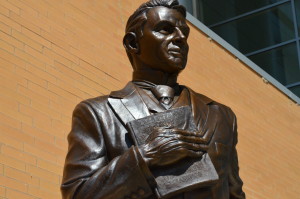
William Alden Smith (1859-1932) – William Alden Smith was a U.S. Senator from Grand Rapids, best know for chairing the committee that investigated the sinking of the Titanic. He was also a Republican presidential candidate in 1916.
located near the Monroe Avenue entrance for DeVos Place Convention Center
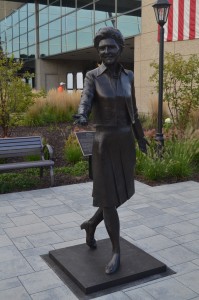
Betty Ford (1918-2011) – Elizabeth Anne “Betty” Bloomer was born in Chicago and raised in Grand Rapids. She became an accomplished dancer and was fashion coordinator for Herpolshieimer’s Department Store. On October 15, 1948, she married Gerald R. Ford. Together they had four children: Michael, Jack, Steven, and Susan. Gerald Ford served as a Michigan congressman for twenty five years. Then, on August 9, 1974, he became President of the United States, and Betty became the nation’s First Lady. As First Lady, she openly discussed her personal battle with breast cancer and raised the nation’s consciousness on women’s rights. She later became a strong advocate for treatments for cancer and chemical dependencies. After the Fords left the White House in 1977, Betty remained a selfless leader on a number of issues and continued her dedication to public service and humanitarian efforts.” Sculpture by J. Brett Grill, 2018.
located in front of the Gerald R. Ford Presidential Museum, 303 Pearl St. NW
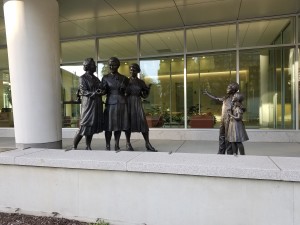
Adulation: The Future of Science, honoring Grace Eldering Sc. D. (1900-1988), Pearl Kendrick Sc. D. (1890-1980) and Loney Clinton Gordon (1915-1999) – “During the 1930s and 40s, Pearl Kendrick, Sc. D and Grace Eldering, Sc. D., along with the assistance of Loney Clinton Gordon, developed the vaccine for whooping cough in a Michigan Department of Health lab in Grand Rapids. The vaccine has saved the lives of millions of children around the world. May their achievements, and all who continue their legacy of life-saving research, be an inspiration to a new generation of scientists.” Sculpture by Jay Hall Carpenter.
Located in front of the Michigan State University Research Center, 400 Monroe Ave. NW

